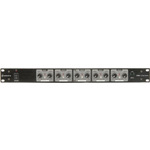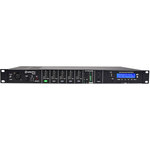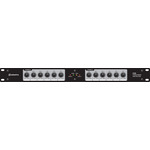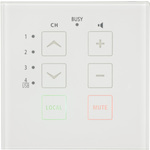Zoning Systems
Sound systems are often installed in public spaces to deliver spoken word, music and other audible information to listeners in many different environments.
The most simple sound system might be a microphone connected to an amplifier and speaker unit to deliver speech at a volume loud enough for a group of people to hear. More sophisticated systems may need to be able to deliver high quality stereo background music and voice announcements with different sound sources delivered to different areas or groups of listeners.
Zoning systems are flexible sound systems that provide control for the sound that is delivered to different areas, called “zones”. A zone can be a room or a group of rooms. Equally, a zone could be part of a room or even an outside space. Essentially, wherever separate control over the amplified sound is needed would be considered as a separate zone.
In the example diagram below, a building has been separated into 5 zones.
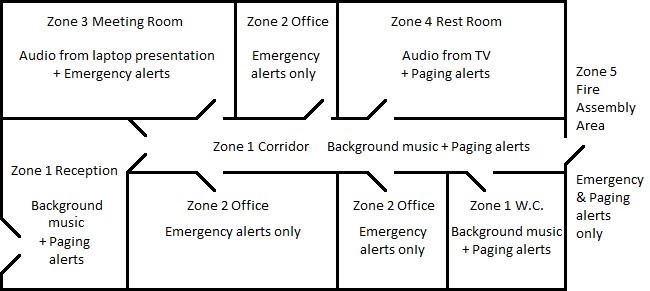
This is a flexible 5 zone system, allowing different sound sources to different zones.
Public areas, such as reception, corridor and W.C. are served by Zone 1 output to receive the same background music along with voice paging alerts.
All offices are served by Zone 2 because they never require background music and only ever need the emergency alerts that are broadcast to all zones.
The meeting room has its own independent Zone 3, as it needs audio from a laptop to be amplified to the room for presentations and video conferences. Emergency alerts are also active in this zone.
The rest room has its own Zone 4, so that audio from a TV can be amplified to the room, whilst still receiving emergency alerts along with paging alerts to send voice messages to the room.
Finally, Zone 5 is the fire assembly area at the rear of the building, which requires emergency and paging alerts in case of fire or other emergency drills.
For each office and public area to be separately controlled, more zones would be needed.
Since most buildings are different, there are different options to provide sound system zoning control to meet the criteria of each installation. It might only be necessary to switch the sound off or on to certain zones. For this requirement, a simple switching system can be used.
Adastra RM240S - 953.215UK

Adastra RM240S and RM360S mixer-amplifiers provide 4 separate relay-switched 100V outputs to enable separate switching of 4 zones. In this type of system, all 4 zones deliver exactly the same sound when they are switched on.
Adastra RM244V - 953.244UK

To add individual control over the volume in each zone, it is possible to use individual volume controls. The Adastra RM244V has 4 built-in attenuators to enable control of the output volume to 4 separate 100V outputs. Again, the sound produced at each zone will be the same but the output level of each can be adjusted.
Fully independent control of each zone would mean that each zone can produce a different sound at whichever output level is required. This can only be achieved if each zone has its own separate amplifier and source selector. The most obvious solution might be to use a completely separate amplifier for each zone but this also means that it is more difficult to feed the same signal to all zones (including emergency alerts) and adjust the outputs from a single control panel.
Adastra A8 - 953.408UK

Adastra A2, A4, A6 and A8 amplifiers offer stereo output to 4Ω or 8Ω speakers with control over 1, 2, 3 or 4 zones respectively. Microphones are fed to all zones for paging and alerts and each zone has 4 source options (including the internal media player) and independent volume control.
Adastra Z5M- 953.019UK

The Adastra Z5M zone mixer can mix 2 stereo sources to any of 5 zones with fully adjustable output levels. The 5 outputs can be fed to a 5-way amplifier, such as the Adastra RS605 slave amplifier, or to separate amplifiers or even active speakers in each zone.
Adastra RZ45 - 953.045UK

For total flexibility, the Adastra RZ45 is a 5 zone audio matrix with source and output volume fully controllable via touch-operated wall plates, which can be located within each relevant zone or elsewhere.
Any of the 5 zones can be fed from 3 selectable audio sources or the internal media player and the level of each is independently adjustable.
Overall emergency paging to all zones is provided by a paging mic input and an optional call station can address individual zones for voice messaging as needed.
Again, the output can feed an Adastra RS605 or 5 separate amplifiers or even active speakers in each zone.

Adastra TR-86 – 953.050UK

Adastra RS605 – 953.151UK


